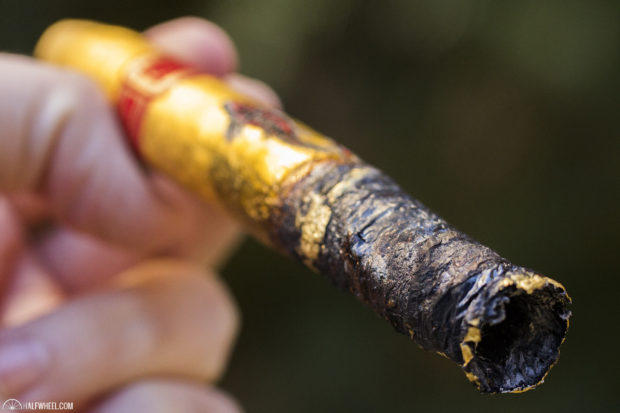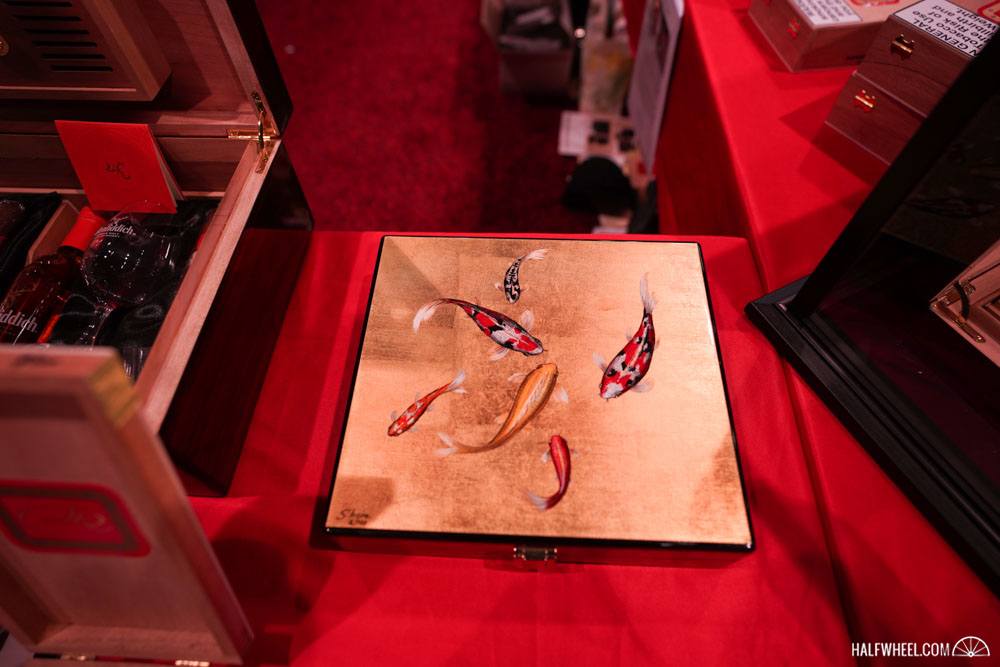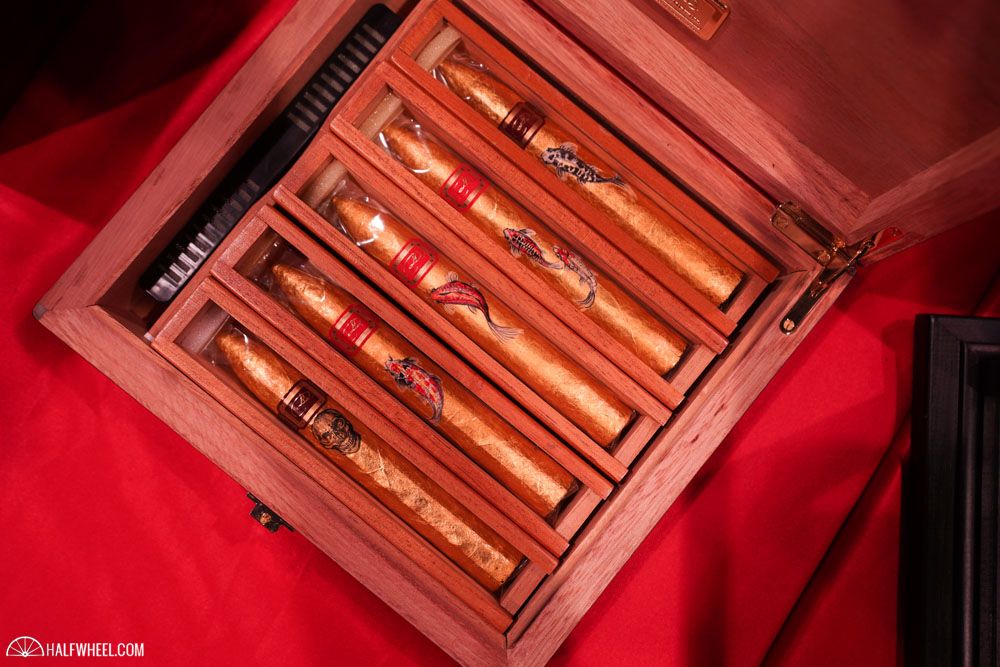There truly is no limit to luxury if you’re willing to look hard enough and open up your wallet enough. Case in point: a cigar that is not just wrapped in 24kt gold, but was shipped to Germany so that koi could be hand painted on it.
Before the cigars got to that point though, it’s worth going back to the summer of 2011, when noted humidor maker Daniel Marshall made a cigar wrapped in edible 24kt gold in honor of a friend’s birthday. While he didn’t seem to intend it for it to get an official release, the story goes that after seeing the reactions from people at the party, he decided to use the cigar as part of a humidor he was designing for Universal Studios the would commemorate the movie Scarface, including one in each box.
The cigar is based on the DM2, a Nicaraguan puro using a five-year-old wrapper, binder from Estelí and fillers from Jalapa. That cigar—which was created by Manuel “Manolo” Quesada Jr. and made at Plasencia Cigars S.A.—is also available sans gold for around $11 in the 6 1/4 x 54 vitola that it shares with its gold-wrapped counterparts.
But the Daniel Marshall Art Cigar isn’t just an off-the-shelf offering. While the 24kt Golden Torpedo received another release in 2012 as part of the company’s 30th anniversary celebration, in 2018, it was time to up the ante even further.
To do that, Marshall starts with the regular process, taking a DM2 Torpedo and applying 24kt Italian gold leaf by hand in his California workshop. To do this, he uses an ultra fine sand paper to make the surface of the cigar as smooth as possible. The gold is then applied with a natural adhesive, using a total of 25 sheets of gold leaf for each cigar.
From there, they are shipped to Germany, where a painter applies an edible ink painting of a koi fish or two. While the name of said artist has not been disclosed, Marshall did say that it is someone who allegedly worked on the restoration of the Sistine Chapel as well as cathedrals and other historic locations.
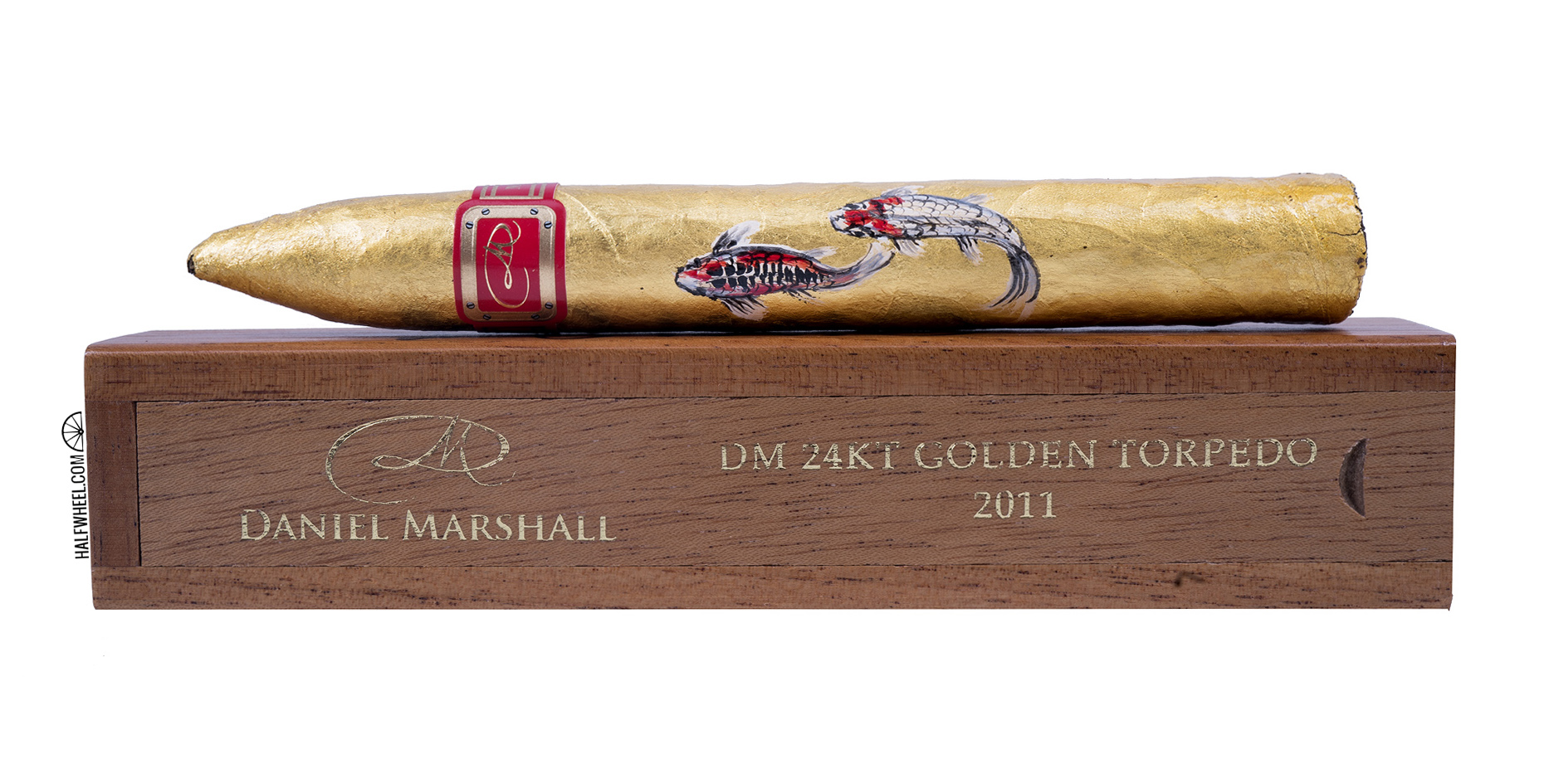
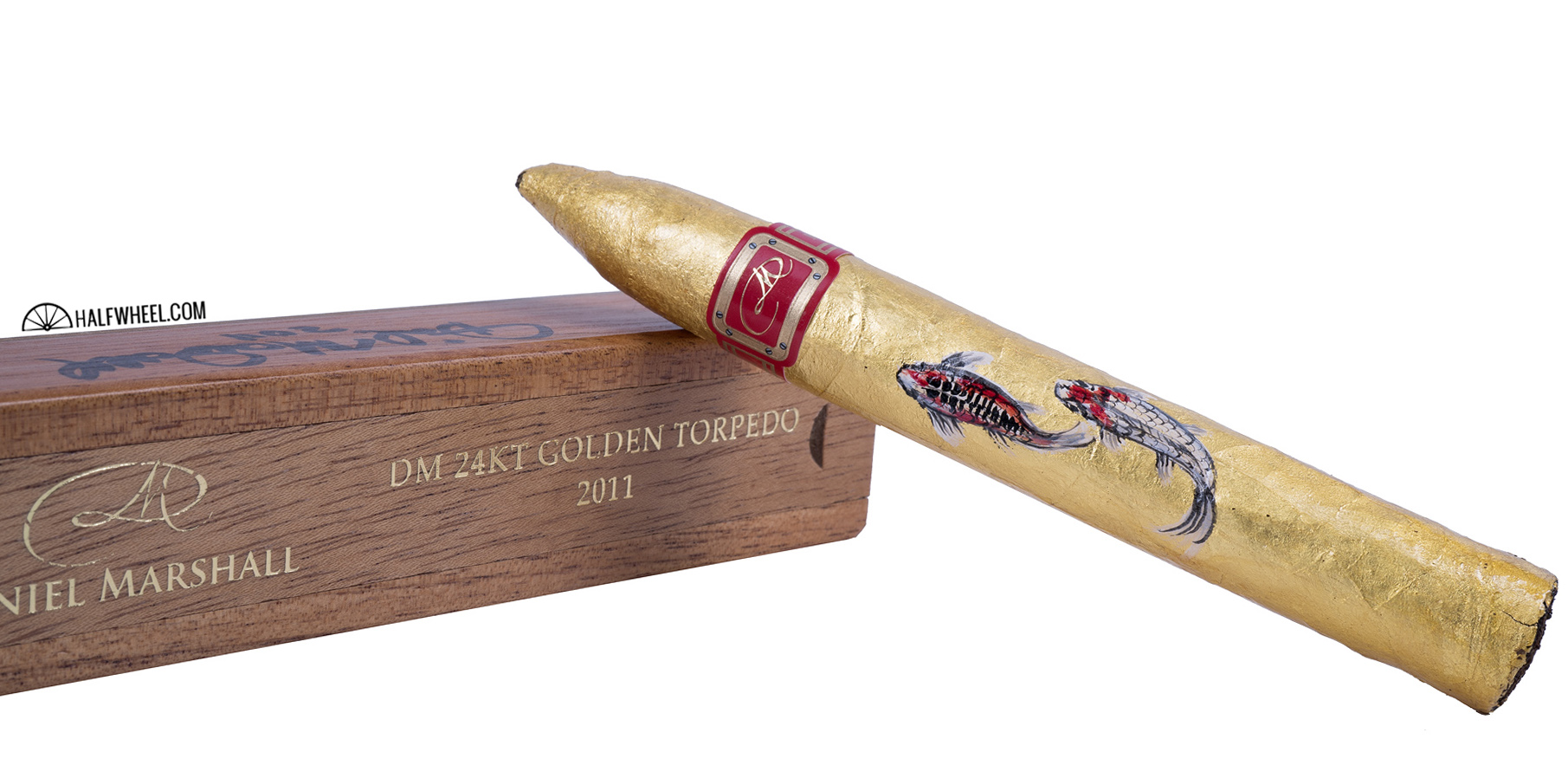
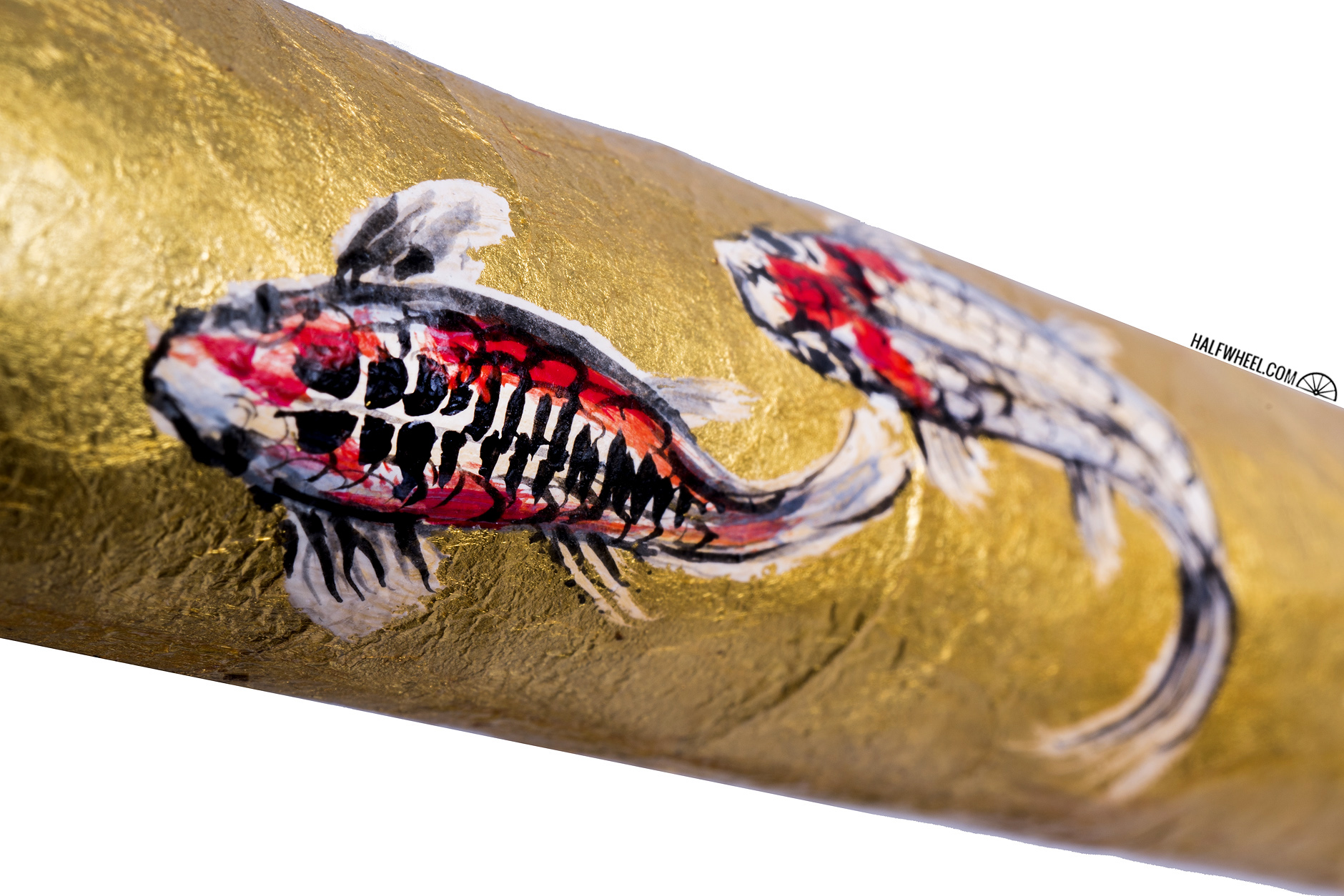
Once the koi have been painted on, the cigars head back to California where they are packed in five-count travel humidors, with the lid covered in gold and a painting of more koi fish, and finished with a price tag of $4,995. And yes, they can be smoked.

- Cigar Reviewed: Daniel Marshall Art Cigar
- Country of Origin: Nicaragua
- Factory: Plasencia Cigars S.A.
- Wrapper: Nicaragua
- Binder: Nicaragua (Estelí)
- Filler: Nicaragua (Jalapa)
- Length: 6 1/4 Inches
- Ring Gauge: 54
- Vitola: Torpedo
- MSRP: $999 (Boxes of 5, $4,995)*
- Release Date: Summer 2018
- Number of Cigars Released: n/a
- Number of Cigars Smoked For Review: 1
The cigar, which comes packaged in a coffin, shows up from our office in a Daniel Marshall-branded pouch with fairly thick plastic and what appears to be a brochure of some sort tucked in the back, as well what I think might be a humidification device that from the outside feels like folded-up paper towels. While I’m correct about the brochure, there’s no integrated humidification, instead, a few small Boveda packs do the job. The coffin throws me off a bit as it indicates the cigar inside is the 24kt Golden Torpedo, which was released in 2011 and is noted as such on the box, while one side of the box has been signed by Daniel Marshall with the year 2011. I’m relieved to find that the cigar inside is the correct one once I slide off the lid, and it’s necessary to take a few moments to truly appreciate just what sits in front of me. The cigar comes in cellophane, which I expect from a protection standpoint but also interferes with truly soaking in the visual. The gold does a good job allowing the texture of the wrapper leaf to show through, as I can see a healthy network of veins but otherwise have no idea what the cigar looks like. The drawing of the koi are quite impressive, certainly better than I could pull off with weeks of practice and the fact that I wasn’t trying to draw them on a cigar. Once out of the cellophane, there is definitely a metallic foil texture to the wrapper as it feels nothing like a traditional cigar. It’s quite firm to the touch, and it doesn’t need much of a squeeze to reveal just how solid it is. The foot has a bit of cool milk chocolate to it, reminding me a bit of a Hershey’s bar pulled out of the fridge. There’s a bit of pepper in there as well, though it is fairly subdued. The wrapper itself, meanwhile, offers nothing of note other than its texture. The cold draw is smooth and easy, once again showing the note of convenience store holiday chocolate candy as the most discernible note.
While the foot of the cigar lights quite normally—albeit it a bit slowly towards the edges—when the flame approaches the gold it causes it to bubble a bit, which I have to confess is slightly concerning. It also looks like the top of a creme brûlée with the burnt sugar color and shine. The cigar seems to be lit evenly and is putting off a decent amount of smoke, although when I turn it over to inspect the burn it seems that the outer layers of tobacco aren’t burning as well as the inner portion. Flavor-wise, it feels fairly restrained, with a bit of chocolate-covered espresso beans as one thing that I recognize. There’s very little pepper to be found on puffs but I am left with a bit of tingle on my lips, as well as an oily and slightly sweet finish on the tongue. Smoke production ebbs and flows in the first third, swinging from Drew Estate-like levels to barely any, and when I feel that a relight is needed, the cigar flames up after a couple of puffs and turns the once-gold sides almost completely black. Judging by the first 20 minutes or so, with seemingly very little of the cigar burnt, this is going to require fairly regular puffing to keep up combustion. One thing that becomes immediately clear is that I have no idea where the burn line is, and given the billing that the gold melts over the ash, I’m really not sure if I should be tapping it off in hopes of finding some fresher tobacco to relight instead of toasting the foot again. Just for kicks I give the Art Cigar a quick shake to see if anything drops off, and I find that about an inch worth of tobacco from the center of the has dislodged, one of the worst examples of tunneling I can recall from a cigar. Determined to get something out of this cigar, I give that a relight to only minimal avail, as I can get the cigar smoking again ever so slightly, with little in the way of flavor making it to my taste buds, that is until it suddenly gains traction and puts out smokestack amounts of smoke. Not only do I feel like the gold has been applied expressly to work against me smoking the cigar, I also have no idea exactly where the burn line is. I will say that near what I think is the end of the first third, the cigar is back to burning decently with a neutral profile marked by cream, a bit of peanut butter and increasing amounts of black pepper, with more pepper to be found through the nose.
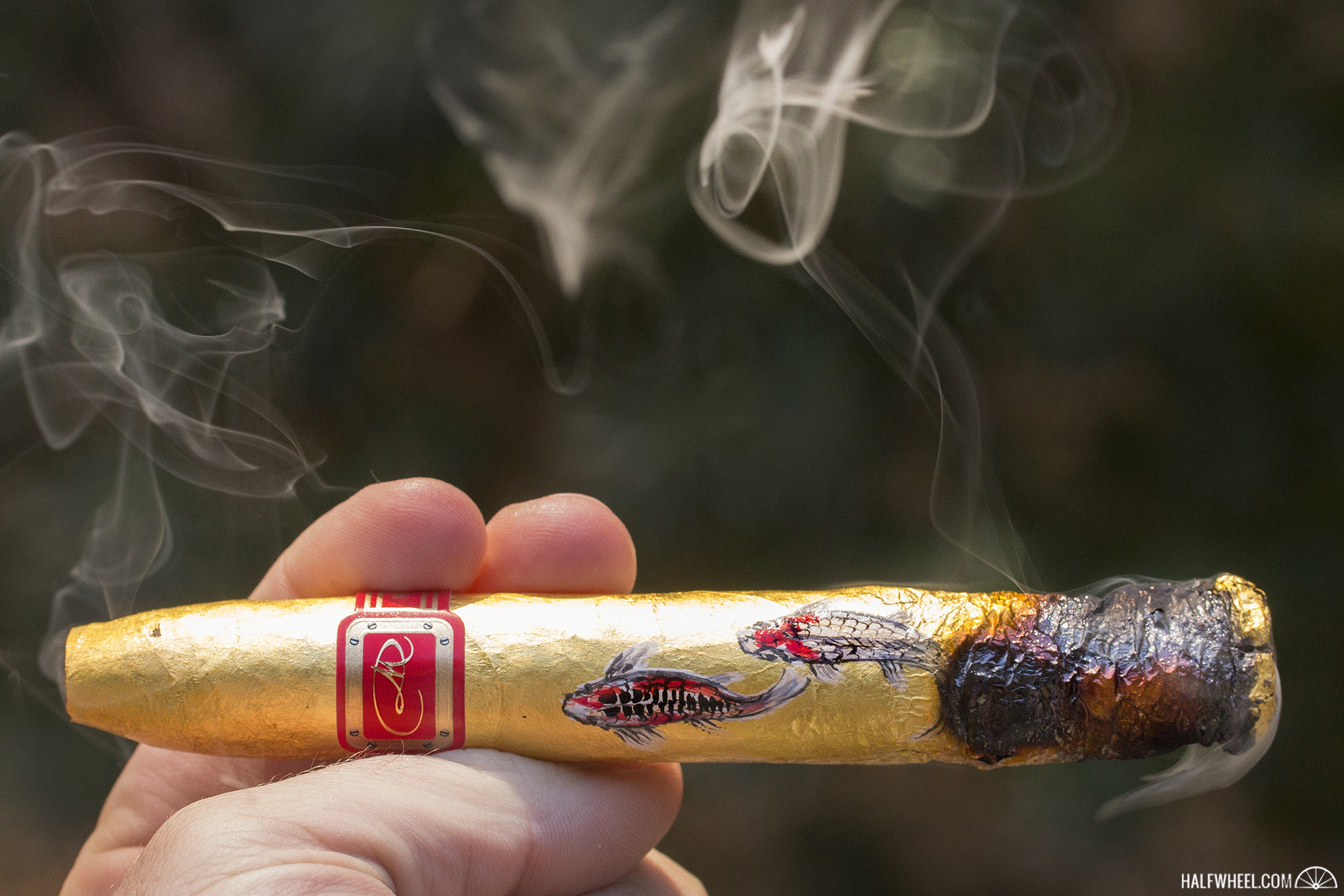
Given the combustion issues of the first third, I’m intently focused on keeping this thing burning, and almost as soon as I write that while fairly fervently puffing away, the thing seems to go out once again, going from a smoke factory to one that didn’t pay its bill and has had the power cut off. As the tail of the lower koi begins to burn, I realize that the gold foil is actively working against me by hampering combustion, something that Brooks Whittington experienced when he smoked the 24kt Golden Torpedo. The frustration was so bad that I called Brooks just to make sure we were having similar experiences. I finally concede the idea of smoking this all the way through and decide to cut the offending half of the Art Cigar off to get a clean foot in hopes of salvaging this nearly four-figure cigar. With some unburnt tobacco to start with in the tail end of the second third, the cigar lights fairly quickly and gets right to work in terms of smoke production, though the flavors still are quite muted and show little change from what I picked up in the first third. The combustion of the gold is better here as well, not turning nearly as black as it had in the first third, though it still has a bubbled, charred aspect to it in spots. The smoke continues to go from billowing to almost non-existent rapidly, seeming a prime indicator that the internal combustion issues remain with this cigar, and that’s despite fairly good air flow. When I can get a decent puff, the smoke has a little more pepper to it, seeming to head down a path of black pepper before quickly shifting and replacing almost all of it with a brighter white pepper.
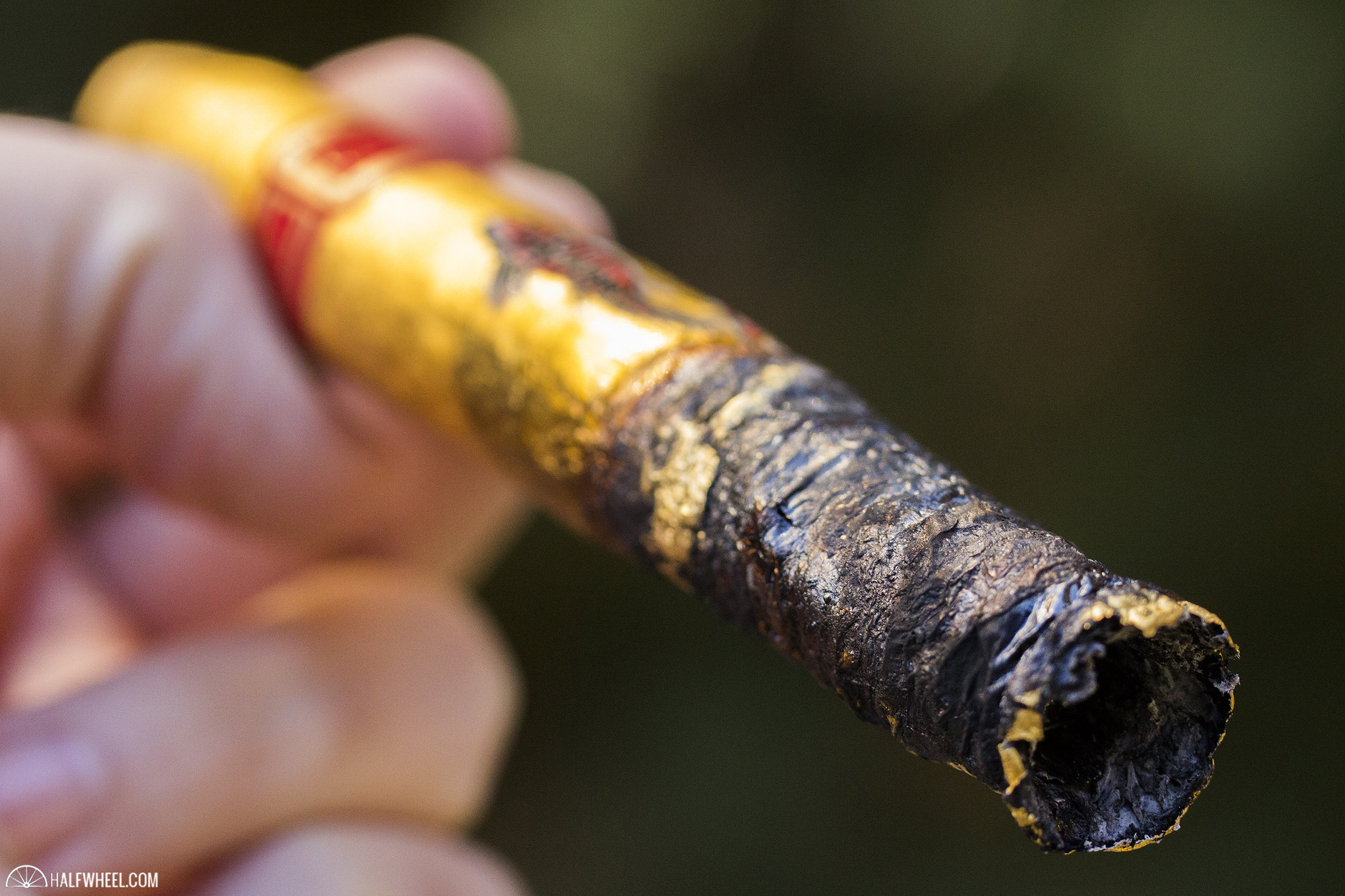
The final third begins with me holding onto a thread of optimism that I’ll be able to get the Daniel Marshall Art Cigar burnt down to a reasonable nub, as well as enjoying the flavors as much as might be expected given the burn issues. The profile is very light and creamy now, with a bit of pepper but hardly enough to be considered being even pepper-forward. If anything, I’m curious what the ratio of viso to seco is in the filler, as I’d think it would make sense to lean more on the latter simply for combustion, probably eschewing ligero all together. Removing the band takes off a bit of the gold leaf, though at this point that’s an afterthought at best. The gold leaf is doing a better job showing where the burn line is, going from fairly smooth to slightly wrinkled as the burn line passes underneath it, with my fingers able to confirm that by feeling increased amounts of heat from the cherry. Combustion starts to struggle again as the burn line approaches the band, and with about two inches left I’m seriously considering whether or not to attempt a relight through the gold or a cut and relight, the latter of which seems most likely to succeed, all things considered. I give the first a try that quickly goes nowhere, so I pull out a pair of cigar scissors to give cigar as best a chance to finish strong. It definitely works, with the disappointment of not getting the full gold-covered ash experience left long behind. Unfortunately, the flavor has begun to turn as well, taking on a funky coffee profile that reminds me of something I’d find in a less-than-reputable convenience store or diner. It’s the first puffs where I’ve been disappointed by the profile, as while it hasn’t been particularly complex or deep to this point, it’s been enjoyably passable through the first five inches. The final inch and half burns fairly well with the intended gold leaf-covered ash materializing well, though the flavor is now turning a bit metallic and leaving a sting in the back of the throat, suggesting the time has come to put the cigar down, even though the cigar is burning about as well as it has to this point. Some chalk comes in to seal the finish as less than stellar on the palate.
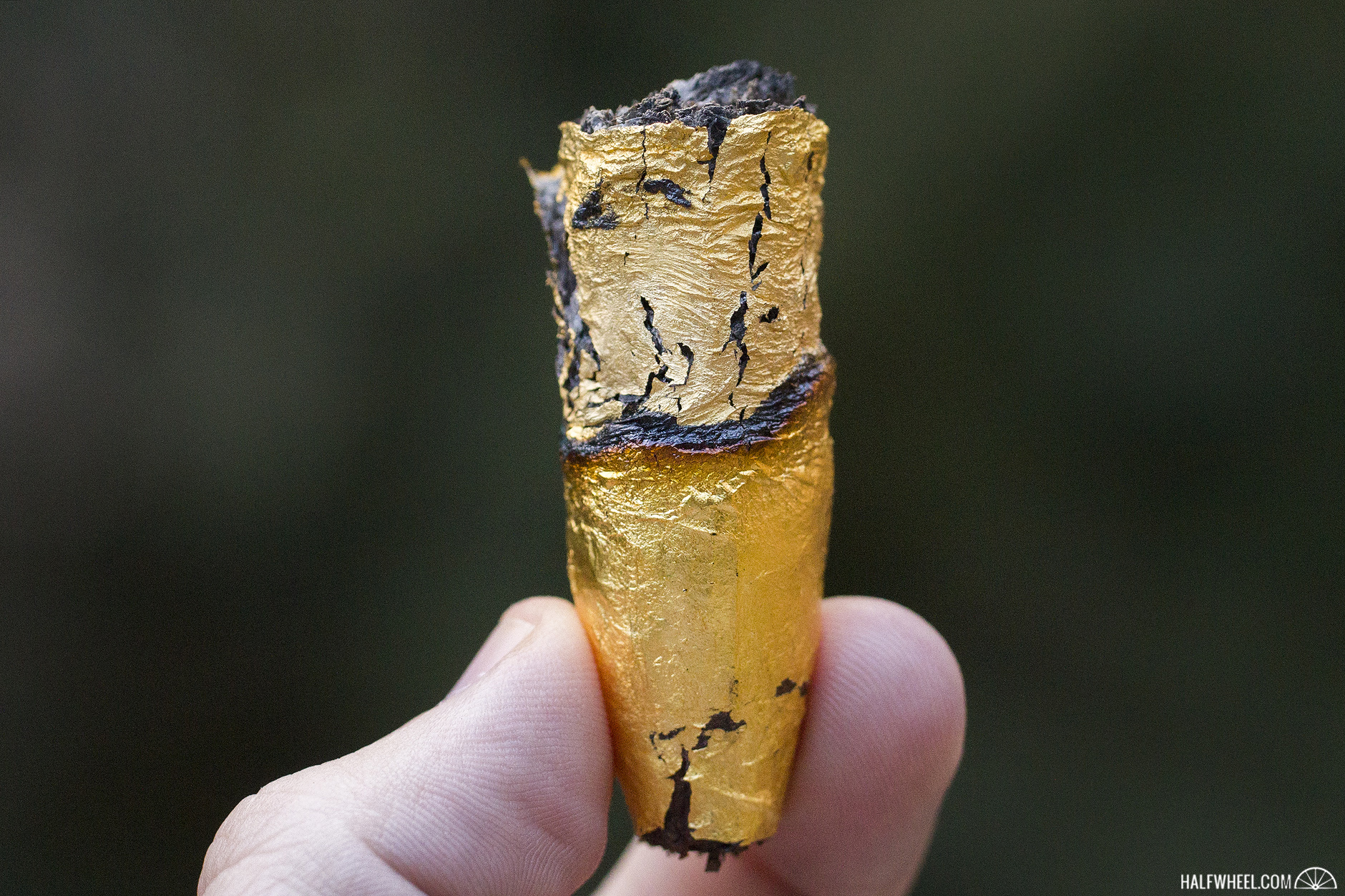
Final Notes
- There is an interesting faint white outline left by the koi once they burn through, almost as it a marker had been put down as to where to draw them.
- To borrow from a conversation with Brooks Whittington that I had about our experiences with this cigar, I’d rather get one of these in, say, a box of 10 cigars, with the other nine actually smokable like a regular cigar and this one meant to be displayed.
- If you’ve seen Portlandia, I thought of the line about putting a bird on it when I saw this cigar, except in this case it’s koi.
- Daniel Marshall talked about the Art Cigar during Charlie Minato’s visit to his booth at the 2018 IPCPR Convention & Trade Show.
- I found there to be absolutely no nicotine strength from the Daniel Marshall Art Cigar.
- On our score sheet, we have a yes or no field for would you buy it? based off appearance and this is the first cigar I can remember stopping to really ponder that question.
- Given that these cigars come in five-count travel humidors, I don’t think it’s completely fair to just take the total cost and divide by five to get the per stick MSRP. If the humidor was valued at $500, that knocks the per cigar cost down to just under $900. To my knowledge, there is no reported value of the humidor on its own, though the humidor for the 24kt Golden Torpedo from a few years ago was valued at $250.
- Production numbers have not been disclosed, other than that it is a limited production.
- Final smoking time was one hour and 40 minutes on average.
- The cigar for this review was provided by Daniel Marshall.
As with any cigar smoked for a review, I tried to go into the Daniel Marshall with no preconceived notions or expectations, other than that it should be at least a decent experience. The Daniel Marshall Art Cigar did impress me in terms of flavor, as while incredibly mild and basic, was enjoyable and palatable until the final inches. However, the burn and combustion issues caused by the gold were simply unacceptable, seemingly working against me at nearly every puff. There’s little more to say about the Daniel Marshall Art Cigar that while it is a great cigar to look at, it is not a particularly great cigar to smoke.

